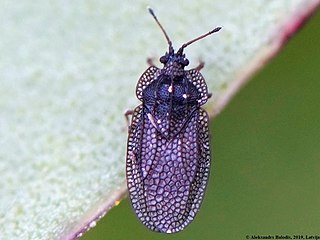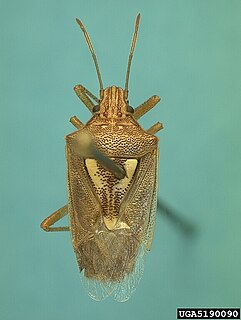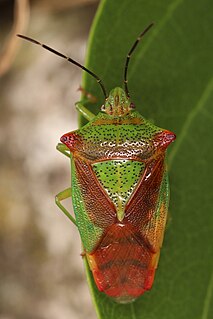
Pentatomidae is a family of insects belonging to the order Hemiptera, generally called shield bugs or stink bugs. Pentatomidae is the largest family in the superfamily Pentatomoidea, and contains around 900 genera and over 4700 species. As hemipterans, the pentatomids have piercing sucking mouthparts, and most are phytophagous, including several species which are severe pests on agricultural crops. However, some species, particularly in the subfamily Asopinae, are predatory and may be considered beneficial.

Acanthosomatidae is a family of Hemiptera, commonly named "shield bugs," for which Kumar in his 1979 world revision recognized 47 genera; now this number is 55 genera, with about 200 species, and is one of the least diversified families within Pentatomoidea.

Rhynocoris is a genus of assassin bug, family (Reduviidae), in the subfamily Harpactorinae. Species are recorded from Asia, mainland Europe, Africa and North America.
Holcostethus is a genus of shield bugs belonging to the family Pentatomidae, subfamily Pentatominae.
Sciocoris is a genus of shield bugs belonging to the family Pentatomidae, subfamily Pentatominae. The genus was erected by Carl Fredrik Fallén in 1829.
Tytthus is a genus of insects in family Miridae, the plant bugs. They are carnivorous, feeding upon the eggs of various planthoppers in the family Delphacidae, and thus are important in the biological control of pests. The genus is distributed throughout the Holarctic of the Northern Hemisphere, but species are also found in the tropics, in China, South America, Australia, and the Indo-Pacific.

Acalypta is a genus of lace bugs in the family Tingidae. This genus is closely related to Dictyonota, Kalama and Derephysia: in the tribe Tingini.

Mormidea is a genus of stink bugs in the family Pentatomidae. There are about five described species in Mormidea.
Buenoa is a genus of backswimmer. It was created by George Willis Kirkaldy in 1904 to include all species of Anisops from the Western Hemisphere with a two-segmented front tarsus in males, reserving the latter genus for Eastern Hemisphere species with a one-segmented front tarsus in males. It contains 69 described species.

Oebalus is a genus of stink bugs in the family Pentatomidae. There are about six described species in Oebalus.

Carpocorini is a tribe of stink bugs in the family Pentatomidae. There are about 15 genera and at least 50 described species in Carpocorini.

Orthocephalus is a genus of plant bugs in the family Miridae. There are more than 20 described species in Orthocephalus.

Podisus is a genus of predatory stink bugs in the family Pentatomidae. There are at least 20 described species in Podisus.

Phimodera is a genus of shield-backed bugs in the family Scutelleridae. There are about 11 described species in Phimodera.

Dictyonota is a genus of lace bugs in the family Tingidae. There are more than 60 described species in Dictyonota.

Acanthosoma is a genus of shield bugs in the family Acanthosomatidae, found in Europe, Asia, and Oceania. There more than 20 described species in Acanthosoma.
Rhopalimorpha is a genus of insects in the shield bug family Acanthosomatidae. It is native to Australia and New Zealand. There are four species in the genus, of which three are found in New Zealand.

The Discocephalinae are a subfamily of shield bugs, erected by Fieber in 1860, and found worldwide.













